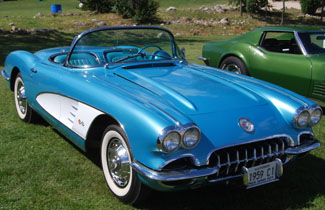Corvette History 
Select a year and a model to view the vast history of Corvettes.
All Models

“Everything’s Coming Up Roses”—a Top 10 tune in 1959—could have been the ‘Vette’s theme song for the year. With the exterior cleaned up from ‘58, but few mechanical changes, Chevrolet’s sports car started getting great reviews in the automotive press. Ray Brock of Hot Rod had only good things to say when he road tested the ‘Vette roadster and Road & Track described the ‘59 as “a pretty package with all the speed you need and then some.”
Motor Trend tested the ‘Vette against a Porsche 356 convertible in its April 1959 edition and the only thing the Porsche could boast about afterwards was better fuel economy. All other kudos went to the ‘Vette, which accelerated and handled better. People in the know were starting to recognize the fact that the ‘Vette, even if not the most exotic car around, was becoming a “world-class” sports car with a price tag much lower than the competition in that category.
The unnecessary tinsel found on the ‘58 ‘Vette—a fake hood louvers and vertical chrome strips on the trunk—were gone. Interior changes included redesigned bucket seats and door panels, a fiberglass package tray under the “sissy” bar and concave gauge lenses. Listing for $3,563—about $100 less than in 1958—the ‘Vette had a production run of 9,670 units for the model year.
A tach, an outside rearview mirror, seat belts for the driver and passenger, dual exhausts and an electric clock were among the standard features. Interior sun visors became optional equipment. New concave instrument lenses reduced reflections. The optional four-speed manual transmission had a T-shaped reverse-lockout shifter with a white plastic shifter knob. There were plenty of performance options, but Ray Brock said, “There is absolutely no need for any of the heavy-duty racing extras unless the car is intended for sports car racing.”
There were seven exterior body colors offered for 1959 Corvettes: Tuxedo Black (available with a Black or White soft top), Classic Cream (Black or White soft top), Frost Blue (Black, White or Blue soft top), Crown Sapphire (Black, White or Turquoise soft top), Roman Red (Black or White soft top), Snowcrest White (Black, White, Tan or Blue soft top) and Inca Silver (Black or White soft top). Blue, Red, Turquoise and (for the first time) Black interiors were listed. The armrests and door handles were in a different position in the 1959 model, its seats had a new shape and a shelf was added.
Under-hood options were the same as in 1958. All power options were based on the 283-cid “small-block” Chevy V-8, which came in five versions. A 230-hp rating was standard and options included 245-, 250-, 270 and 290-hp engines. The respective torque ratings were 300, 300, 305, 285 and 290 foot-pounds. A 3.70:1 rear axle ratio was standard with 4.11:1 and 4.56:1 options.
The 290-hp fuel-injection engine with the 4.11:1 rear axle was the hot setup in ’59. A car so equipped could do 0-to-60-mph in 6.8 seconds and had a top speed around 128 mph. It could do the standing start quarter mile in 14.9 seconds with a trap speed of 96 mph. By comparison, a car with the mid-range 250-hp engine took a second longer to reach 60 mph. It could do the quarter mile in 15.7 seconds at 90 mph and its flat-out top speed was around 120 mph.
The ‘Vette again rode on a 102-inch wheelbase with a 177.2-inch overall length. The front tread was 57 inches and the rear was 59 inches. The fiberglass body was 72.8 inches wide and height to the top of the windshield was 51.6 inches. A new Saginaw recirculating ball steering system had a 17:1 ratio, 3.7 turns lock-to-lock and a 38.5-foot turning circle. At 2,842 pounds the ’59 weighed about 60 pounds more than a ’58 model.